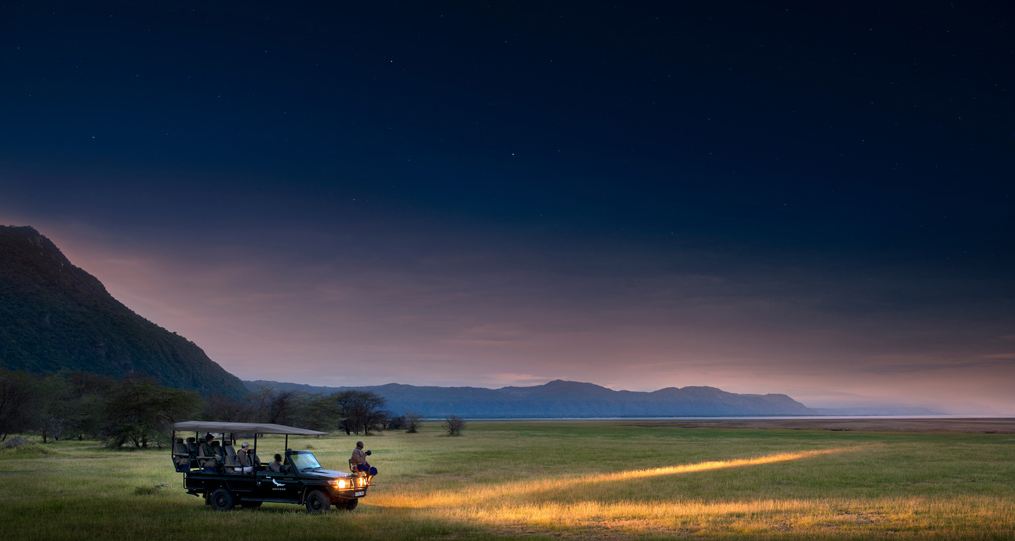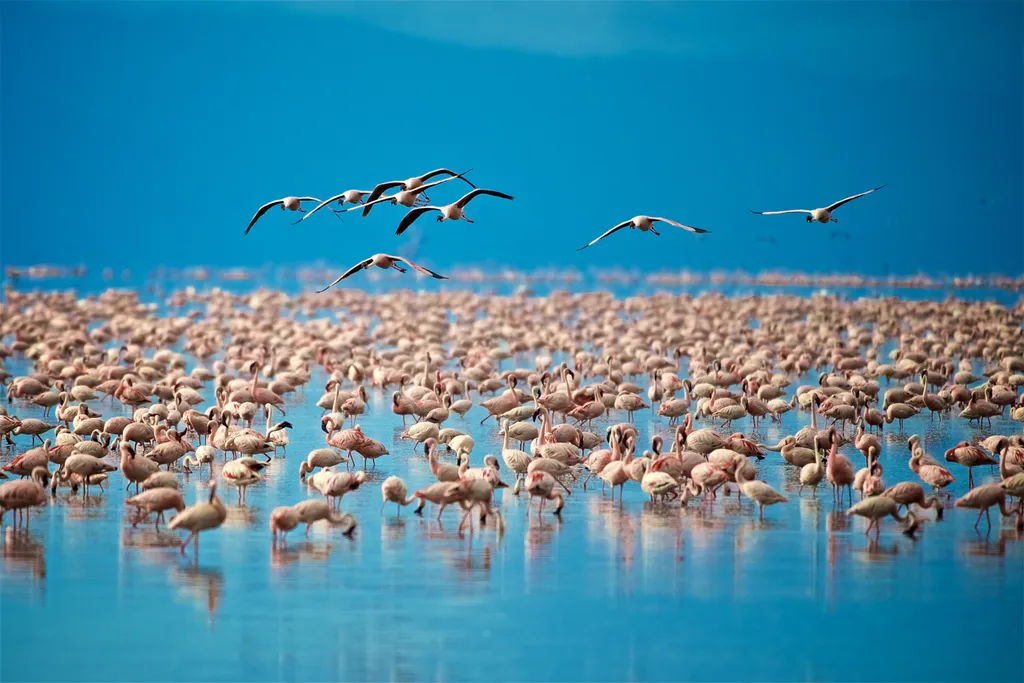Table of Contents
ToggleWhile planning their northern Tanzania safaris, travellers always wonder: Is Lake Manyara worth visiting, why visit Lake Manyara National Park, what is special about Manyara National Park? Yes, Lake Manyara is worth visiting.
In this article, we bring you all the exclusive details and anything that makes Lake Manyara special and worth visiting during your Tanzania safari. From fabulous flocks of flamingoes, and huge herds of elephants to tree-climbing lions, Lake Manyara National Park has some seriously unique safari features.
Reasons To Visit Lake Manyara National Park

1. Uncrowded, Remote & Quiet
Perfectly complementing a safari tour in Ngorongoro Crater, Tarangire, and Serengeti National Park, Lake Manyara National Park is a hidden gem among Tanzania’s astonishing array of safari destinations. And there are fewer safari cars here, particularly in the morning, to obscure the scene and potentially frighten away the animals. Lake Manyara National Park is a tranquil sanctuary that invites you to enjoy unhurried wildlife safari game drives, free from the crowds and bustle of the more “popular” Tanzania wildlife safari parks.
2. The Beauty of Lake Manyara Itself
Spanning some 325 km2, this remarkable Tanzania safari park is adorned by the lake, which claims a generous portion of 230 square kilometers for itself.
Described by Ernest Hemingway as the ‘loveliest I have seen in Africa’, this vast expanse of shimmering waters serves as a stunning backdrop to your wildlife safari adventures.
So, we recommend you keep your camera at the ready! Not only does the mirror-like surface of the lake reflect the beauty of the passing wildlife, but it also undergoes a magical transformation at sunset. As the sun paints the sky, Lake Manyara becomes a living canvas adorned with otherworldly hues, resulting in truly picture-perfect moments.
Lake Manyara was formed as a result of the Great Rift Valley. Over millions of years, as the rift grew wider, streams cascaded down it’s continually eroding slopes and pooled into what is now the famous lake. Characteristic of lakes formed in this way, Manyara has no outlet and is, therefore, exposed to intense evaporation, enabling salt and other minerals to accumulate.
Crusty white deposits of soda glitter like diamonds around the edge of the water and the saline water appears virtually soapy in texture due to the concentrated minerals.
3. Striking Landscapes and Scenery
Lake Manyara National Park lies at the foot of the dramatic Great Rift Valley escarpment.
The Rift Valley itself is a massive rupture in the surface of the Earth. It splits the landscape along a fault some 6500 kilometers from the Red Sea to the Zambezi River. It is one of the Earth’s few geological features that can be seen from the moon.
Much of the park’s 330km² is taken up by the lake but one of the many surprises in store for visitors is the remarkably wide diversity of terrestrial habitats and abundant foliage that creates a captivating medley of landscapes.
You will find an intricate patchwork of complex ecosystems including the groundwater forest, sprawling acacia woodlands, the grassy floodplains, and of course the lake itself.
Along the edge the lake’s edge, you will see a mesmerizing tapestry of marshlands and glistening salt flats. And on the western shore, the impressive Rift Valley escarpment descends gracefully to meet the lake’s waters.
In just a two-hour safari trip excursion into Lake Manyara National Park, it is possible to see all the main highlights in the groundwater forest and the floodplains leading up to the lake.
Overall Lake Manyara is an exquisite gem. Small but lovely, and splendidly diverse, this park is a true scenic retreat for the eyes and the soul.
4. The Rare Tree-Climbing Lions
Lake Manyara National Park is one of the few places in Africa where you can see the remarkable lions that climb trees. The other place to see them is Queen Elizabeth National Park in Uganda.
Most of the African lions stick to the ground. And you find them lazing among the grasses, on top of rocks, and sheltering from the sun under trees. But at Lake Manyara National Park, these Africa’s biggest predators have truly mastered the art of arboreal adventures.
You will have a chance to see them effortlessly perching on tree branches like seasoned acrobats. It indeed is quite an experience to look up into the trees and find yourself face to face with a pride of lions.
5. The Stunning concentration of Elephants
Another great reason why Lake Manyara National Park is worth visiting on your safari in Tanzania is that it has an epic concentration of elephants.
The park has some greatest elephant concentrations in East Africa. What makes Lake Manyara Park an elephant haven lies in the perfect harmony of factors that define their habitat.
The park’s bountiful offerings of nourishing food and water sources, along with its protected environment, have created an idyllic sanctuary for these majestic gentle giants.
Manyara is, in fact, one of the best places to watch elephants in the world. And the first long-term field study of elephants in the wild was conducted here and the book entitled “Among the Elephants” by Iain and Oria Douglas-Hamilton documents this pioneering work.
6. Large Flocks of Pink Flamingos

Another of our favorite features of Lake Manyara National Park is flamingos.
These comical birds often congregate together – feeding on the garden of blue-green algae that flourish in the shallows. Posing in large numbers on their tall stilts of legs with their pink plumage reflecting in the still water, the first sight of these colorful birds is really quite remarkable.
Lake Manyara is home to both lesser and greater flamingoes, the two species of the bird native to Africa. The greater flamingo features whitish-pink feathers, pink legs, a pink bill with a black tip, and black-edged wings. The lesser flamingo weighs around half the size of the greater flamingo and is shorter.
They are much the same in appearance but can be easily distinguished by their black bills and their much pinker plumage. These statuesque birds have long legs, they can wade into much deeper water than most birds, and their webbed feet help support them on soft mud.
Flamingos also have an endearing habit of standing on one leg. The reason why they do this is because curling a leg under the body keeps the foot warm and conserves body heat.
Before taking flight, a flamingo must run some steps before it lifts into the air, with great wings outspread to catch the lifting undercurrents. They fly with their body completely extended – neck and head outstretched in front of their body with legs trailing horizontally behind.
It is interesting to note that the flight speed of a flock of flamingos can reach up to 60 kph and these birds have been known to fly up to 600 km each night between stops for food.
7. Lake Manyara National Park Is a Wildlife Haven
In addition to flamingos, elephants, and tree-climbing lions, Lake Manyara National Park is home to a variety of other wonderful wildlife. Here, you can spot graceful giraffes nibbling on treetop foliage, witness the plains zebras, wildebeest, and buffalo dotting the grassy plains.
Keep your eyes peeled for elusive leopards stealthily moving through the vegetation. The leopards of Lake Manyara National Park, though abundant, are elusive.
Only the occasional lucky visitor ever glimpses a leopard in Manyara. But if you are interested in seeing a leopard, make sure to spend two nights in the Central Serengeti’s Seronera Valley. This is the best place to see a leopard in perhaps all of Africa.
Primates in Manyara include Vervet monkeys, blue monkeys, and Olive baboons. Manyara boasts the highest concentrations of baboons in Africa. The baboons are among the more exciting animals to watch in the park as they squabble and quarrel in their large extended family groups.
Baboons live in large communities called ‘troops’ of up to 200 individuals and defend fixed territories belonging to the females. Other mammals in Lake Manyara National Park include;
- Hippos
- Gazelles
- Impalas
- Waterbucks
- Bushbuck
- Dik-dik
- Warthog
- Spotted hyaena
- Jackals
- Honey Badger
- African Clawless Otter
- Egyptian Mongoose
8. Lake Manyara Is a bird-watching paradise
It is often said that Lake Manyara National Park is one of best the parks in Africa for bird watching. The park’s diverse variety of habitats hosts over 400 species of birds.
50 of these are birds of prey, including various types of eagles. As noted above, the park is known for the flocks of thousands of flamingoes that feed along the edge of the lake. Other special birds in Lake Manyara National Park include:
- Yellow-billed Stork
- Grey Heron
- Greater Painted-snipe
- Chestnut-banded Plover
- various ducks
- herons
- egrets
- cormorants
- kingfishers
- jacanas
- plovers
- lapwings
- Palm-nut Vulture
- Ayre’s Hawk-eagle
- Martial, Tawny, and Crowned Eagle
- Gabar Goshawk
- Abyssinian Scimitarbill
- Bare-faced Go-away-bird
- White-headed Buffalo Weaver
- Blue-capped Cordon bleu
- Eastern Violet-backed Sunbird
- Southern Ground Hornbill
- Purple-crested Turaco
- Silvery-cheeked Hornbill
- Baglafecht Weaver
- Grey-olive Greenbul
- Crested Guineafowl
- D’arnaud’s Barbet
- Superb Starling
- Lilac-breasted and European Roller
- Fischer’s Lovebird
- Black Bishop
9. There's so much to do in Lake Manyara National Park
Game viewing is the main safari activity at Lake Manyara. However, there are also many other great things to do at Lake Manyara National Park. These include:
- Night game drives (if you stay at the park’s lodge)
- Treetop Walkway (great for spotting Lake Manyara National Park birds and monkeys)
- Canoe safari on Lake Manyara (water level permitting)
- Village cultural tour (like one visiting a Maasai boma) just outside of the park
- Picnic or enjoy a bush meal at the Majimoto host spring, Msasa, or Endalla picnic sites
- Naturel walk along the raised boardwalk at the Majimoto hot springs for fantastic Lake views
- Mountain biking tours
- Abseiling down the Rift Valley escarpment
- Guided evening walking safari along the Msasa or Lake Shore trail
- Walking the raised boardwalk to the Hippo Pool Viewpoint, from where you can see the lake, escarpment, and, of course, many hippos!
- Forest walk along the Great Rift Valley escarpment just outside of the park
Recommendations
We find that a quick day visit to Lake Manyara National Park incorporated on any Tanzania safari itinerary between the Ngorongoro Crater and Arusha or the Ngorongoro Crater and Tarangire is ideal for most travelers. The national park gate is just a few feet from the main road. And this combined with the fact that the park is small allows for quick and rewarding forays into the park.
Also, the majority of the wildlife found in the park is usually located close to the park gate. The walkway around the visitor’s center at the park gate is actually the best spot to see the stunning blue monkey. A two to four-hour visit to Lake Manyara National Park makes a superb addition to any safari itinerary. Contact us to plan your trip and experience the undeniable charm of Lake Manyara on your next African adventure in Tanzania.
